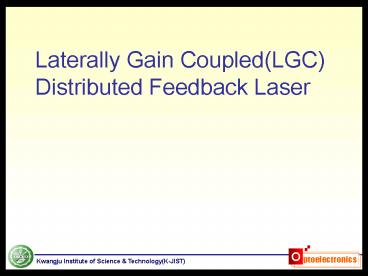Laterally Gain CoupledLGC Distributed Feedback Laser - PowerPoint PPT Presentation
1 / 12
Title:
Laterally Gain CoupledLGC Distributed Feedback Laser
Description:
2. Patterning (Mask Aligner, spin coater, Hologram Lithography system) ... Hologram Lithography. Ability to make fine grating patterns. Ability for mass production ... – PowerPoint PPT presentation
Number of Views:45
Avg rating:3.0/5.0
Title: Laterally Gain CoupledLGC Distributed Feedback Laser
1
Laterally Gain Coupled(LGC) Distributed Feedback
Laser
2
DFB-LD for 1.55um Communications Window
- 1.31um communication window has zero dispersion
- 1.55um communication window has High chromatic
dispersion
3
Why DFB?
- Conventional FP LDs spectral width is around
34nm which introduces limitation in long
distance communication due to chromatic
dispersions from the fiber in the 1.55um region
with data rate of 2.5Gbps.
Dl 0.5nm
Dl 34nm
B bit ratebits/s L transmission
lengthkm D dispersionps/nm/km Dl spectral
widthnm
4
Conventional PBH DFB LD
- Over-Growth required for grating fabrication
- Complex Process and Growth steps
- Introduction of defects due to process and
overgrowth steps.
1
4
1. Grating Fabrication 2. 1st Regrowth(QW,
Cladding) 3. Mesa Etching 4. 2nd
Regrowth(Current Blocking Layer) 5. 3rd
Regrowth(Contact layer) metal contact
2
5
3
5
LC DFB LD
- No Overgrowth steps in the fabrication
- Simple fabrication method
- High Single Mode Yield due to metal grating
1
- Ridge grating fabrication
- Metal contact fabrication
2
6
Comparison of Complex/Index coupled DFB-LD
- Absorptive Grating
- Single Mode Yield
- As Cleaved 41
- AR Coated 52
- Average kink power
- 44mW
- Index Grating
- Single Mode Yield
- As Cleaved 19
- AR Coated 31
- Average kink power
- 35mW
7
Steps for LC DBF LD fabrication
Laterally Complex Coupled
8
Laboratory resources for DFB LD fabrication
- 1. Growth (MBE)
- 2. Patterning (Mask Aligner, spin coater,
Hologram Lithography system) - 3. Dry Etching system( RIE, ICP )
- 4. Deposition systems( E-beam evaporator, PECVD)
- 5. Etc( RTA, SEM)
ltMBEgt
ltICPgt
ltLithography Systemgt
ltSEMgt
ltMask Alignergt
ltE Beam Evaporatorgt
9
Hologram Lithography System
10
Grating produced by Hologram Lithography
- Ability to make fine grating patterns
- Ability for mass production
- Simple and easy fabrication
- Short process time
Advantages
- Inability to make free pattern
- Sensitivity to natural vibrations
disadvantages
11
Grating produced by E-Beam Lithography
- Ability to create complex patterns less than 1?
directly on wafer, without mask. - Computer assisted patterns.
- Ability to provide extremely accurate layer to
layer registration - Can also be used to accurately detect features of
the substrate
Advantages
- Poor Efficiency
- Long Process Time
- High Cost
disadvantages
12
Laterally Coupled DFB LD

